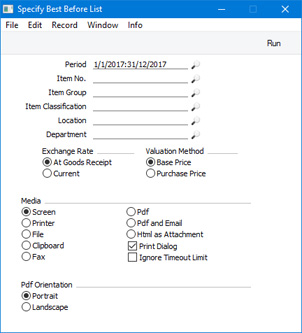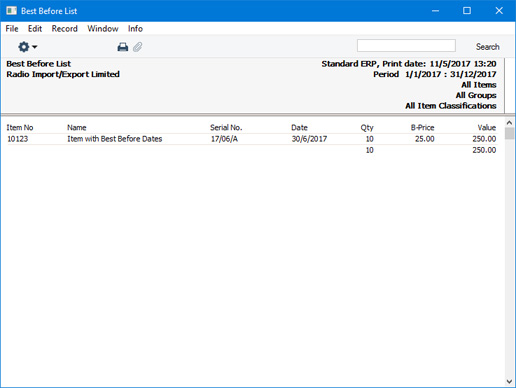Best Before List
The Best Before List report is a list of the Serial Numbers with Best Before Dates that are currently in stock. It includes Items that are Serial Numbered at the unit and batch levels. The Best Before Dates will be taken from the
Batch Specifications setting. Serial Numbered Items that do not have Best Before Dates will not be included in the report.
For each Serial Number, the report shows the Item Number and Name, Serial or Batch Number, Best Before Date, quantity in stock, unit sales or purchase price and value (quantity in stock * unit price).

- Period
- Paste Special
Reporting Periods setting, System module
- Enter the start and end dates of the reporting period. The report will list the Serial Numbers that are in stock and that have Best Before Dates that fall within this period.
- Item No
- Paste Special
Item register
- Range Reporting Alpha
- To restrict the report to particular Items, enter an Item Number or a range of Item Numbers separated by a colon (:) here.
- Item Group
- Paste Special
Item Group register, Sales Ledger
- Range Reporting Alpha
- If you need Items belonging to a particular Item Group to be listed in the report, specify that Item Group here. You can also enter a range of Item Groups.
- Item Classification
- Paste Special
Item Classifications setting, Sales Ledger
- Enter a Classification Code in this field if you only need Items with a certain Classification to be included in the report. If the field is empty, all Items, with and without Classification, will be included. If you enter a number of Classifications separated by commas, only those Items featuring all the Classifications listed will be shown. If you enter a number of Classifications separated by plus signs (+), all Items featuring at least one of the Classifications listed will be shown. If you enter a Classification preceded by an exclamation mark (!), all Items featuring any Classification except the one listed will be shown.
- For example:
- 1,2
- Lists Items with Classifications 1 and 2 (including Items with Classifications 1, 2 and 3).
- 1+2
- Lists Items with Classifications 1 or 2.
- !2
- Lists all Items except those with Classification 2.
- 1,!2
- Lists Items with Classification 1 but excludes those with Classification 2 (i.e. Items with Classifications 1 and 2 are not shown). Note the comma before the exclamation mark in this example.
- !1,!2
- Lists all Items except those with Classification 1 or 2 or both. Again, note the comma.
- !(1,2)
- Lists all Items except those with Classifications 1 and 2 (Items with Classifications 1, 2 and 3 will not be listed).
- !1+2
- Lists Items without Classification 1 and those with Classification 2 (Items with Classifications 1 and 2 will be listed).
- (1,2)+(3,4)
- Lists Items with Classifications 1 and 2, and those with Classifications 3 and 4.
- 1*
- Lists Items with Classifications beginning with 1 (e.g. 1, 10, 100).
- 1*,!1
- Lists Items with Classifications beginning with 1 but not 1 itself.
- *1
- Lists Items with Classifications ending with 1 (e.g. 1, 01, 001).
- 1*,*1
- Lists Items with Classifications beginning and ending with 1.
- Location
- Paste Special
Locations setting, Stock module
- If you need the report to list the Serial Numbers that are in stock in a specific Location, specify that Location here.
- Department
- Paste Special
Departments setting, Assets module/System module
- Enter a Department Code if you need the report to list the Items that you have assigned to a particular Department (using the Department field on the 'Stock' card of each Item record).
- Exchange Rate
- These options are only used if the Valuation Method (below) is "Purchase Price", and with Serial Numbers that were received into stock using Goods Receipts and Returned Goods records in Currency (i.e. not with Serial Numbers that were received into stock using Productions or with Serial Numbers that were moved from one Location to another using Stock Movements).
- If you received a Serial Number into stock using a Goods Receipt or Returned Goods record in Currency, these options will specify whether its purchase price in the report will be converted to your home Currency using either the Exchange Rate from the time of receipt (FIFO principle) or the Exchange Rate at the time of the report. The time of receipt is recommended, because it will show the same values as the FIFO value.
- Valuation Method
- Use these options to specify whether the report should show the sales price of each Serial Number (i.e. the Item's Base Price, from the 'Pricing' card of the Item record) or its purchase price (from the Goods Receipt, Production, Returned Goods record or Stock Movement).

---
Reports in the Stock module:
Go back to:
